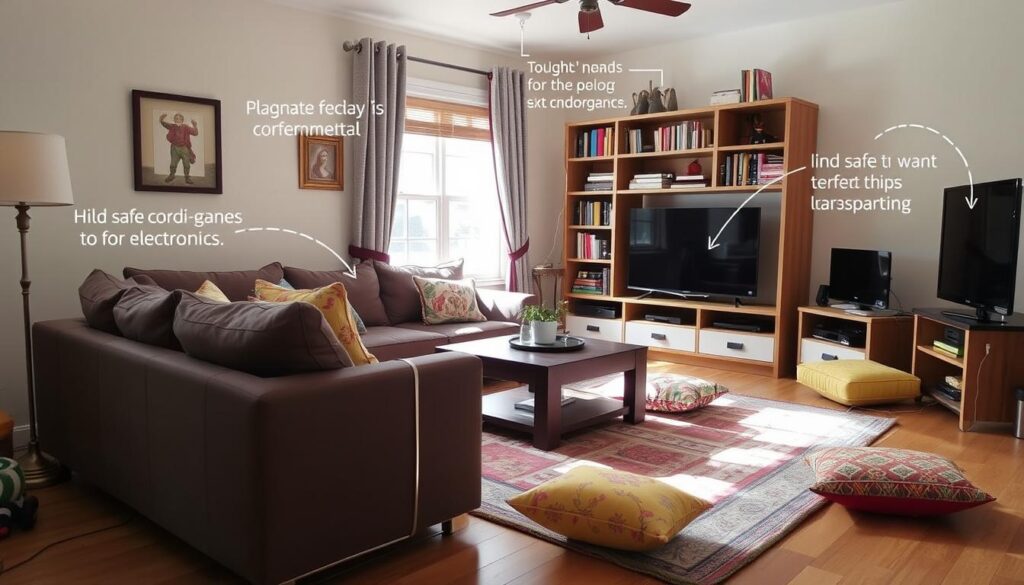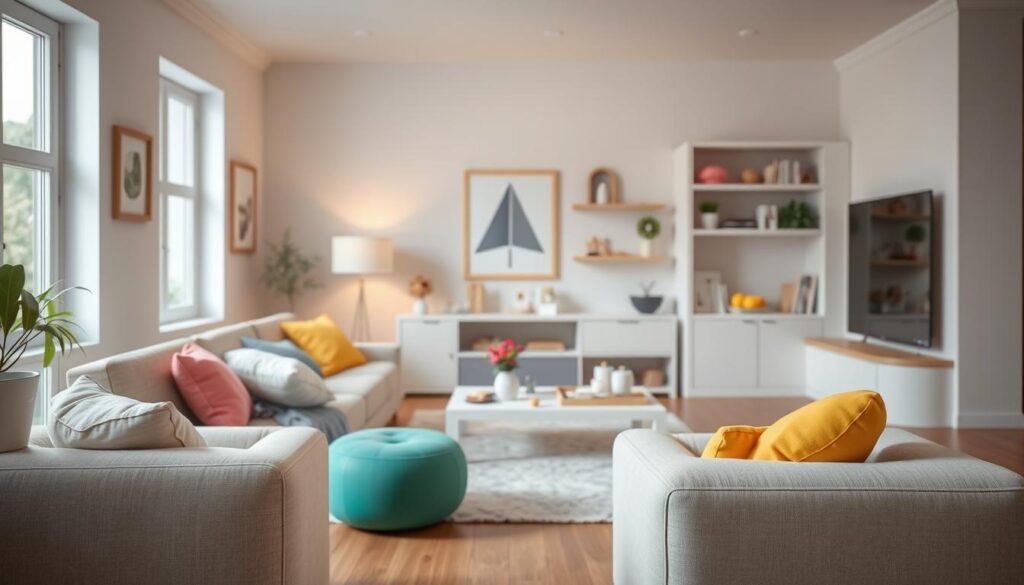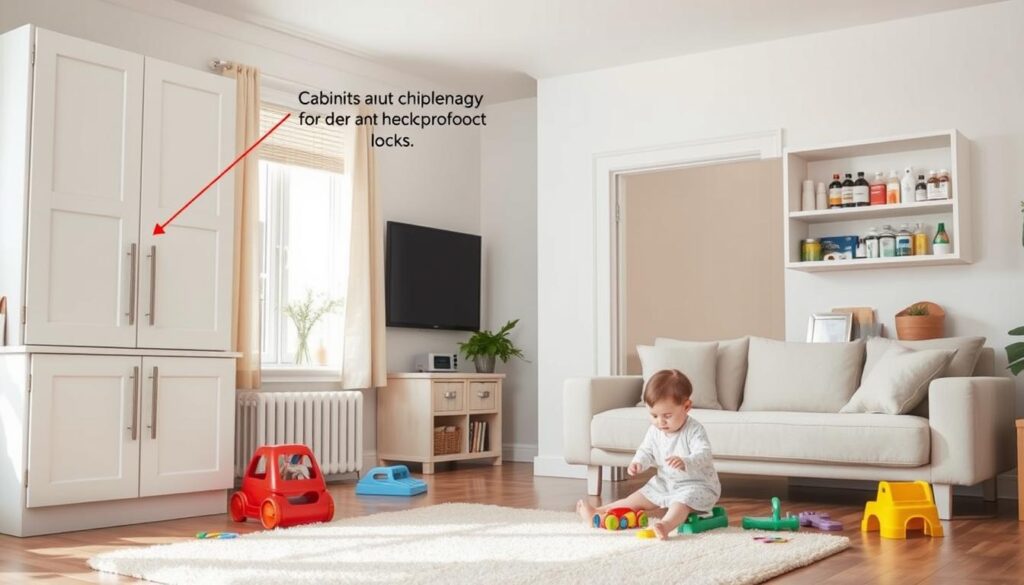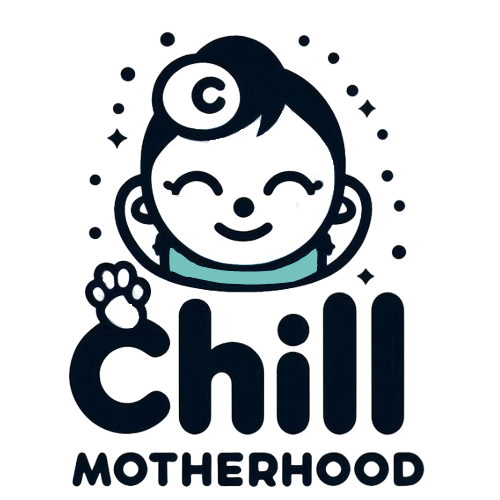As a parent, making your home safe for your baby is crucial. Baby-proofing might seem hard, but it’s doable with the right steps. This guide will show you how to make your home safe and fun for your little one.
Contents
- 1 Understand the Risks in Your Home
- 2 Secure Heavy Furniture and Electronics
- 3 Install Safety Gates and Barriers
- 4 Cover Electrical Outlets and Cords
- 5 Create a Safe Play Area
- 6 Store Hazardous Items Out of Reach
- 7 Maintain a Safe Kitchen Environment
- 8 Baby-Proof the Bathroom
- 9 Create an Emergency Plan
- 10 Regularly Review Your Baby-Proofing Measures
- 11 FAQ
- 11.1 What are the most common household hazards for babies?
- 11.2 How can I secure heavy furniture and electronics to prevent tip-over accidents?
- 11.3 What are the different types of safety gates and where should I place them?
- 11.4 How can I properly cover electrical outlets and manage cords?
- 11.5 How do I create a safe play area for my baby?
- 11.6 Where should I store hazardous items to keep them out of reach?
- 11.7 How can I baby-proof the kitchen to prevent accidents?
- 11.8 What bathroom safety measures should I take to protect my baby?
- 11.9 How can I prepare an effective emergency plan for my family?
- 11.10 How often should I review and update my baby-proofing measures?
Key Takeaways
- Identify potential hazards in your home and take proactive measures to minimize risks.
- Secure heavy furniture and electronics to prevent tipping and falling accidents.
- Install safety gates and barriers to restrict access to dangerous areas like stairways.
- Cover electrical outlets and manage loose cords to prevent electrical shocks and strangulation.
- Create a safe and engaging play area for your baby to explore safely.
Understand the Risks in Your Home
Getting ready for a new baby is thrilling, but it’s also a time to think about safety. It’s key to know the common dangers in your home and how babies interact with their world. By spotting risky spots, you can make your home safer for your little one and avoid accidents.
Common Hazards for Babies
- Sharp corners on furniture
- Loose cords and cables
- Choking hazards, such as small toys or loose change
- Toxic household cleaners and chemicals
- Drowning risks in bathrooms and pools
Identifying High-Risk Areas
Babies love to explore, which can sometimes lead to danger. Keep an eye on places like the kitchen, bathroom, and living room. These areas often need extra childproofing and accident prevention to keep your baby safe.
How Babies Explore Their Environment
Infants and toddlers explore by putting things in their mouths and pulling on objects. They also crawl or walk around the house. Knowing how they explore helps you spot and fix household hazards to make a safe space for them.
“The best way to keep your child safe is to anticipate and address potential risks before they become a problem.”
Secure Heavy Furniture and Electronics
Childproofing your home is key to making it safe for toddlers. Securing heavy furniture and electronics is a big part of this. Anchoring these items to the wall, managing cables, and choosing safe furniture can help prevent accidents.
Anchoring Furniture to the Wall
Heavy furniture like dressers and bookcases can be dangerous for toddlers. Use anti-tip devices to keep them stable. These simple tools can save your child from harm.
Cables and Cord Management
Loose cables and cords are a choking hazard and can trip toddlers. Organize and secure them to keep your child safe. Use cord covers or route them behind furniture for a clean, toddler-friendly home.
Choosing Safe Furniture Options
Choose furniture that’s safe for children. Look for low-profile, stable pieces with rounded edges. Avoid heavy, tall items that can tip over. Also, pick furniture with built-in storage that can be secured.

Securing heavy furniture and electronics makes your home safer for your toddler. A proactive approach to childproofing is the best way to keep your child safe at home.
Install Safety Gates and Barriers
Keeping your home safe is key when your child is always on the move. Installing baby gates and barriers is a smart move. They act as a physical barrier, keeping your child safe while you keep an eye on them.
Types of Safety Gates
There are many safety gates to choose from. Here are a few popular ones:
- Pressure-mounted gates: These are easy to set up and work well at the top or bottom of stairs without any screws.
- Hardware-mounted gates: These are more secure and need screws in the wall or banister, but they’re a bit harder to put up.
- Retractable gates: They look modern and can be opened and closed easily.
Where to Place Safety Gates
Where you put your baby gates is very important for childproofing. Here are some good spots:
- At the top and bottom of stairs to stop falls
- In doorways to rooms that might be dangerous, like the kitchen or bathroom
- In hallways to block off certain parts of your home
Additional Barrier Options for Stairs
While safety gates are essential for stairs, you can also add more childproofing steps. Consider these options:
- Baby gates with wider openings for wider staircases
- Stair guards or nets to stop little hands and feet from getting stuck
- Wall-mounted safety rails for extra support and stability
Properly installed baby gates and barriers are vital for a safe space for your child. By securing these areas, you can relax and let your child explore safely.
Cover Electrical Outlets and Cords
Electrical hazards are a big risk for curious babies. It’s key to cover electrical outlets and manage cords well. These steps help prevent electrical injuries and make your home safer for your baby.
Outlet Covers: Types and Benefits
Outlet covers are a must for keeping your home safe. They range from simple plastic plugs to tamper-resistant ones. Childproof locks stop small fingers from getting into electrical sockets. This reduces the chance of electrical shocks and burns.
Managing Loose Cords
Loose cords are a big accident prevention risk. Babies might get tangled or pull on them, causing devices to fall. Use cord organizers, covers, and management systems to keep cords neat and out of reach. This boosts safety and makes your home look better.
Safely Using Extension Cords
Use extension cords carefully and keep them away from your child. Don’t let cords cross paths in busy areas, as they could be tripping hazards. Use baby-proofing tips like securing cords to walls or floors to avoid accidents.

“Electrical safety is a critical aspect of baby-proofing your home. Taking the time to cover outlets and manage cords can go a long way in protecting your little one from potential harm.”
Create a Safe Play Area
Creating a safe play area is key for your child’s safety and growth. This area should be both secure and fun. We’ll show you how to pick the right toys, set up a soft play space, and check it often for safety.
Selecting Appropriate Toys
Choosing the right toys is crucial for child safety. Look for toys that match your baby’s age and are safe. Choose soft toys, blocks, and puzzles that are fun and safe for your little one.
Setting Up a Soft Play Space
Make a special area in your toddler-friendly home for play. Use soft mats or rugs to make the floor comfy and safe. Arrange toys and furniture so your baby can move around easily and safely.
Regularly Inspecting the Play Area
- Check the nursery safety of the play area often for hazards like loose cords or sharp objects.
- Make sure all toys are safe and in good shape. Replace any that are broken or unsafe.
- Keep the play area clean and tidy to avoid falls or tripping.
By making a safe and fun play area, you help your child grow and play safely. It’s a great way to encourage their curiosity and development.
Store Hazardous Items Out of Reach
Keeping your little one safe at home is a top priority. This means storing any potentially hazardous items properly. From cleaning supplies and chemicals to medications and sharp objects, it’s crucial to ensure these items are securely stored and out of your child’s reach. Let’s explore some effective ways to childproof your home and prevent accidental exposure or injury.
Cleaning Supplies and Chemicals
Household cleaners, laundry detergents, and other chemicals can be extremely dangerous if ingested or mishandled by curious little hands. Always store these items in a high cabinet or on a shelf that your child cannot access. Consider using child-resistant locks or latches to further secure these cabinets.
Medications and Sharp Objects
Medications, both prescription and over-the-counter, should be kept in a locked cabinet or drawer. Sharps, such as scissors, knives, and razors, should also be stored securely and out of reach. Invest in child-proof containers or locking mechanisms to prevent unauthorized access.
Important Documents and Items
In addition to hazardous items, it’s crucial to safeguard important documents, valuables, and other sensitive items. Consider a locked file cabinet or safe for storing birth certificates, social security cards, and other critical paperwork. Keep small items like coins, buttons, and jewelry away from curious little fingers.
Childproofing your home is an ongoing process, but taking the time to properly store hazardous items can significantly reduce the risk of accidents and injuries. Remember, vigilance and constant evaluation are key to keeping your little one safe from household hazards.

“The best way to keep children safe is to prevent accidents before they happen.”
Maintain a Safe Kitchen Environment
Becoming a parent brings new challenges, especially in the kitchen. Babies can get into trouble if the kitchen isn’t safe. By securing cabinets and drawers and following cooking safety tips, you can make your kitchen safer for your family.
Childproofing Cabinets and Drawers
Kitchens have many dangers, like sharp objects and cleaning supplies. To protect your baby, install childproof locks on cabinets and drawers. These locks come in different styles to fit your kitchen. Always check they work and keep your child away from harmful things.
Cooking Safety Tips
- Use the back burners and turn pot handles inward to avoid accidents.
- Keep hot foods and liquids away from your child to avoid burns.
- Think about getting a stove guard or knob covers to stop your child from turning on the burners.
Safe Food Storage Practices
It’s also important to store food safely. Use baby-proofing tips to keep food out of your child’s reach. Check expiration dates and store perishable items right to keep your home safe and prevent foodborne illnesses.
By using childproof locks, baby-proofing tips, and home safety measures, you can make your kitchen safe for your baby to explore and grow.
Baby-Proof the Bathroom
The bathroom can be a dangerous place for curious toddlers. But, with a few simple steps, you can make it safe. Let’s look at how to baby-proof the bathroom and avoid accidents.
Installing Anti-Tip Straps
Tall, heavy furniture in the bathroom can tip over and hurt your child. To fix this, install anti-tip straps to keep these items stable. This easy fix helps keep your child safe from furniture accidents.
Securing Bathtubs and Sinks
Bathtubs and sinks attract curious toddlers. It’s important to childproof them. Use non-slip mats in the bathtub to stop slips. Also, put safety locks on sink cabinets to keep your child away from water.
Toilet Locks and Other Safety Measures
- Toilet locks: Install toilet locks to stop your child from opening the lid and falling in or playing with the water.
- Secure trash cans: Make sure all trash cans in the bathroom are out of reach or have secure lids to prevent your child from accessing potentially hazardous items.
- Limit access to toiletries: Store all toiletries, medications, and cleaning products in high, locked cabinets to prevent accidental ingestion or exposure.
By using these childproofing tips, you can make your bathroom safe for toddlers. This reduces the chance of accidents and makes a safe space for your child.

“Childproofing your home is an ongoing process, but it’s essential for keeping your little one safe. Take the time to assess and address potential risks in the bathroom, and you’ll be well on your way to creating a accident prevention haven for your family.”
Create an Emergency Plan
Preparing for emergencies is key to keeping your child safe at home. A good emergency plan helps your family act fast and right in a crisis.
Teaching Basic Safety Rules
Begin by teaching your child basic safety rules. These include not touching hot surfaces, staying away from the stove, and avoiding sharp objects. Practice these lessons often and adjust them as your child gets older.
First Aid Kit Essentials
- Bandages (various sizes)
- Antiseptic wipes
- Gauze pads
- Thermometer
- Scissors
- Tweezers
- Adhesive tape
- Pain medication
- Antihistamine
Make a detailed first aid kit and keep it where you can easily find it. Check and update the kit often to make sure it’s ready for emergencies.
Contacting Emergency Services
Put emergency numbers like police, fire, and poison control where they’re easy to see. Teach your child how to call for help and what to say. Practice this with them so they know what to do in an emergency.
“The best way to prepare for an emergency is to have a plan in place before it happens.”
By following these steps, you can keep your child safe and feel more at ease in case of an emergency.
Regularly Review Your Baby-Proofing Measures
Baby-proofing your home is a never-ending task. As your baby grows and moves more, you must check your safety steps often. This keeps your home safe for your child to explore and grow.
Assessing Changes as Your Baby Grows
Check your baby-proofed areas regularly. Look for any changes in your child’s behavior or skills. What was safe before might not be now, as your baby gets more curious.
Make sure safety gates are still in the right place. Check if kids can still get to dangers. Also, see if toys and play areas are still good for your child’s needs.
Inviting Friends to Evaluate Safety
Ask friends, family, or a childproofing expert to check your home’s safety. They might spot risks you missed or offer new ideas. Getting outside views can help you find and fix safety issues you didn’t see.
Keeping Up with New Baby-Proofing Products
The world of baby-proofing is always changing. Keep up with new safety products. Adding the latest safety tech to your home can protect your child even more.
FAQ
What are the most common household hazards for babies?
Sharp furniture edges, loose cords, and electrical outlets are big risks. So are cleaning supplies, medications, and small objects that can be choking hazards.
How can I secure heavy furniture and electronics to prevent tip-over accidents?
Use anti-tip straps or brackets to anchor furniture to the wall. Manage cables and cords well. Choose furniture that’s safe for kids to reduce the risk of accidents.
What are the different types of safety gates and where should I place them?
There are pressure-mounted and hardware-mounted safety gates. Put them at the top and bottom of stairs and in doorways. This keeps your baby away from dangerous areas.
How can I properly cover electrical outlets and manage cords?
Use tamper-resistant outlet covers and organize cords. Also, use extension cords safely. This keeps your baby from getting hurt by electrical hazards.
How do I create a safe play area for my baby?
Choose toys that are right for your baby’s age. Set up a soft, secure play space. Check the area often to keep it safe for your baby to play and explore.
Where should I store hazardous items to keep them out of reach?
Keep cleaning supplies, chemicals, medications, sharp objects, and important documents in high cabinets or locked drawers. This keeps them away from your baby’s curious hands.
How can I baby-proof the kitchen to prevent accidents?
Childproof cabinets and drawers in the kitchen. Use safety measures when cooking and store food safely. This makes the kitchen safer for your family.
What bathroom safety measures should I take to protect my baby?
Install anti-tip straps and secure bathtubs and sinks. Use toilet locks to prevent accidents in the bathroom.
How can I prepare an effective emergency plan for my family?
Teach your child basic safety rules. Put together a first aid kit. Make sure you can quickly call for help in case of an emergency.
How often should I review and update my baby-proofing measures?
Check your baby-proofing often as your child grows. Ask friends to check your home’s safety. Stay up-to-date with new baby-proofing products and techniques to keep your home safe.

